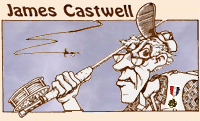|
"Oh boy," I thought as I picked up the two coils of close-out fly line at the Somerset,
NJ fly fishing show. I had used the brand many years back and had liked the way they
had shot through the line-guides. Those were five weights and these were eights but it
was eights I wanted. What luck! I dug out the ten bucks for each and went on my way,
clutching my treasure. Yes, as long as I have been at this, I still get a kick out of buying
things, at a discount makes it even better.
That was a bit over two years ago. I have kept them here in the den and not taken the
time to transfer them to any reels. No reason I guess, just didn't need any new lines,
the ones I was using were doing fine. That was until my wife and I got two new rods
for fishing chum salmon here. Got a couple of eight weight, four piece numbers, easier
to pack in the trunk etc. And I wanted a bit slower and tougher rod for these fish.
Delicate presentation and finesse in casting are lost on these hogs. If ever there was
a specie known for busting up goodies, these baby's are it. I saw one fellow last year
show up with a new fly rod four days in a row, seemed to have a problem with the
rod-tip when landing them.
Anyhow, that was the impetus to mount the two new WF8F lines. We took the new rods
and lines to a stream estuary anticipating a wonderful time casting our new toys. The wind
was up, really up about twenty-five to thirty. In our face. We fished anyway. Testing new
stuff under those conditions is not only a tad difficult, it is darn right impossible. An
un-trained ape could have formed a perfect back-cast and no man alive could have
made a reasonable front cast. So what, we fished as best we could. In fact I got one.
On the drive home I mentioned to the Ladyfisher, the lines seemed a little light, they did
not seem to run in the guides right. Kind of 'sticky' perhaps. The next day, at home, I
took the rods outside and tried a little casting. They still seemed a bit light, but casting
and fishing are not the same thing, I don't care what anyone may tell you. They are
different. Our next fishing venture was a week later with much less wind. No doubt
about it, the lines did not cast the way I wanted them to, that went for both of us. In
fact they stunk, period.
To make the line function I had to shorten my casting stroke utilizing more of the tip
and not the rest of the rod. The line would load the tip, but when the full rod was brought
to power the line would not go through the guides right. Yes, I checked if all the guides were
lined up and I had not missed a guide.
A few days later I striped both those lines off the reels and stuffed them into
the garbage can. I went back to the lines I had used for a few years. One
a Scientific Anglers sinking tip and the other a Cortland weight forward floater,
both eight weights of course. Today I took them to Chico Creek for chum.
I was alone so I had one rod, a reel with one line and a spare spool with
the other line on it. The fish cooperated perfectly. They did not show, which
gave me plenty of time to play with the gear.
The result was, both lines cast just fine. Virtually no difference really, and that was from
very short tip casts using about fifteen feet of line out to the backing knot. Although all the
lines weighed the same, that is, all were eight weights, they cast very differently. The
surface texture and characteristics of the two lines I got at the show made them worthless for
our method of fishing and casting. That is not to say they may not have been alright for
somewhere else under different conditions.
The 'stickiness' of the lines made them 'seem' too light for the rods in that they would
not shoot into the front and back casts. A line that is too light will not have enough
mass and will tend to behave that way. There is a method of casting lines four or five
sizes lighter than the listed weight on a rod, but that is a European method and does
not apply here. It may be a guy needs to look for more than the line weight when
matching a line to a rod, like maybe trying one first? ~ James Castwell
|





